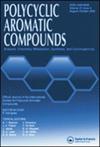Structural, Spectral, Pharmacokinetics Analysis (in-Silico), Drug-Likeness, NCI Analysis (ELF, LOL, IRI & DORI) & Molecular Docking Computations of 2-Hydroxy 2-Phenyl Acetophenone a DFT Approaches
IF 2.6
3区 化学
Q2 CHEMISTRY, ORGANIC
引用次数: 0
Abstract
This article describes a comprehensive study of the structure and spectroscopy of 2-hydroxy-2-phenylacetophenone (benzoin) using density functional theory (DFT) with Gaussian 09 software. Geometrical parameters were calculated at the B3LYP/6-31G (d, p) and 6-311++G (d, p) levels and compared to the literature values. An FTIR and FT-Raman spectroscopy was employed to identify vibrational modes and functional groups. Spectra were obtained in the range of 4000–400 cm−1 (FTIR) and 4000–50 cm−1 (Raman) and compared with theoretical predictions. The optical properties of FMOs are intrinsically linked to their respective energy levels. Consequently, the ΔE Homo-Lumo (ΔE) values were analyzed after the FMO orbitals were meticulously mapped out, and molecular electrostatic potential surfaces indicated regions prone to electrophilic attack, notably O13 and O16. UV spectra were simulated using TD-DFT and CPCM models in various solvents. NBO analysis revealed a stabilization energy of 37.67 kcal/mol, mainly attributed to the donor BD (1) C12-C14 to acceptor BD*(1) (C12-O13) contacts, with an occupancy of 1.93337. Topological indicators (ELF, LOL, RDG, IRI, and DORI) revealed intramolecular and intermolecular connections. The molecule shows potential pharmacological properties, adhering to Lipinski's rule of five, with the lowest binding energy of −6.91 kcal/mol for the 4PES protein. The stability of the target protein was confirmed by the Ramachandran plot.
2-羟基2-苯基苯乙酮的结构、光谱、药代动力学分析(in-Silico)、药物相似性、NCI分析(ELF、LOL、IRI和DORI)和DFT方法的分子对接计算
本文利用密度泛函理论(DFT)和Gaussian 09软件对2-羟基-2-苯基苯乙酮的结构和光谱进行了全面的研究。计算B3LYP/6-31G (d, p)和6-311++G (d, p)水平的几何参数,并与文献值进行比较。利用FTIR和FT-Raman光谱对其振动模式和官能团进行了识别。得到了4000 ~ 400 cm−1 (FTIR)和4000 ~ 50 cm−1(拉曼)范围内的光谱,并与理论预测进行了比较。FMOs的光学性质与其各自的能级有内在的联系。因此,在精心绘制了FMO轨道后,对ΔE Homo-Lumo (ΔE)值进行了分析,分子静电势面显示了易于亲电攻击的区域,特别是O13和O16。采用TD-DFT和CPCM模型模拟了不同溶剂下的紫外光谱。NBO分析表明,该化合物的稳定能为37.67 kcal/mol,主要归因于供体BD (1) C12-C14与受体BD*(1) (C12-O13)的接触,占用率为1.93337。拓扑指标(ELF、LOL、RDG、IRI和DORI)揭示了分子内和分子间的连接。该分子具有潜在的药理特性,符合lipinski5法则,4PES蛋白的最低结合能为- 6.91 kcal/mol。Ramachandran图证实了目标蛋白的稳定性。
本文章由计算机程序翻译,如有差异,请以英文原文为准。
求助全文
约1分钟内获得全文
求助全文
来源期刊

Polycyclic Aromatic Compounds
化学-有机化学
CiteScore
3.70
自引率
20.80%
发文量
412
审稿时长
3 months
期刊介绍:
The purpose of Polycyclic Aromatic Compounds is to provide an international and interdisciplinary forum for all aspects of research related to polycyclic aromatic compounds (PAC). Topics range from fundamental research in chemistry (including synthetic and theoretical chemistry) and physics (including astrophysics), as well as thermodynamics, spectroscopy, analytical methods, and biology to applied studies in environmental science, biochemistry, toxicology, and industry. Polycyclic Aromatic Compounds has an outstanding Editorial Board and offers a rapid and efficient peer review process, as well as a flexible open access policy.
 求助内容:
求助内容: 应助结果提醒方式:
应助结果提醒方式:


